I’m excited to share with you an authentic Greek pastitsio recipe that’s easy and delicious. If you’ve ever had this traditional dish before, then you know the flavors are rich and hearty. Made with pasta, meat sauce, and béchamel sauce, it’s a classic comfort food dish for a reason!
Before we begin cooking, though, I want to take a deep dive into what makes pastitsio so special. We’ll go over its cultural significance in Greek cuisine (and why every household loves it), how it differs from lasagna, and what ingredients you need to get your hands on.
Once we have the basics down, I’ll walk you through making each component step by step. By the time we’re finished layering everything together in a pan, your home will be filled with mouthwatering aromas!
And of course… we can’t forget about side dishes! Don’t worry — I’ll suggest some great options that pair perfectly with pastitsio.
Are you ready to get started? Great! Follow me as we create an authentic Greek pastitsio together.
Discovering the Classic Greek Comfort Food: Pastitsio
Pastitsio, a Greek dish that has reached global fame as a Greek comfort food staple. It’s commonly referred to as the Greek variation of lasagna because of how they’re layered. This dish is prepared by layering pasta with flavorful meat sauce and creamy béchamel sauce, all baked together into perfection..
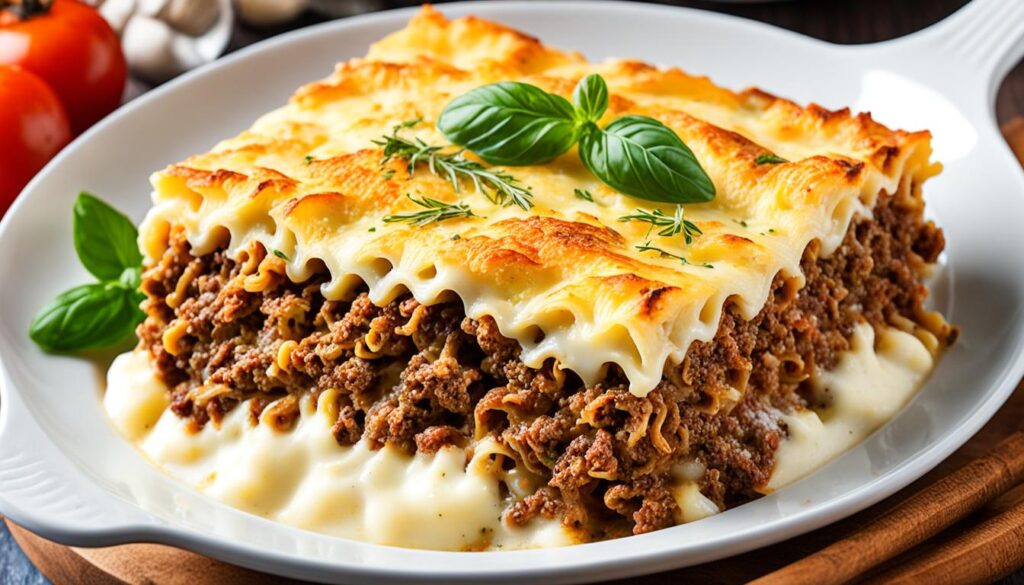
Pastitsio is beloved by Greeks and foodies globally. The hearty, savory dish creates a flavorful chorus with its tender pasta, meaty sauce, and creamy béchamel.
To the Middle Ages we go to trace the root of pastitsio. Greece was under Venetian rule at the time, and they brought layered pasta dishes to the region. Over centuries pastitsio transformed into what we have now: a cultural staple often served during holidays, special occasions, and family gatherings.
By peering into this greek dishes rich history you can begin to understand the traditions and heritage attached to it. A symbol of coming together and celebration for families everywhere..
The Cultural Significance of Pastitsio in Greek Cuisine
Pastitsio is not just tasty. It’s a dish that tells a story about the Greeks. Each recipe represents generations of family and friends coming together during holidays and special events. The Greek culinary world would not be the same without pastitsio, as it has become a symbol of the culture itself.
Pastitsio vs. Lasagna: Understanding the Distinctions
Although pastitsio is often compared to lasagna, it’s important to note that these two dishes are completely different. Knowing this will give you a better understanding of pastitsio and its role within Greek cuisine.
This dish is made up of pasta, meat sauce, and béchamel. It may look like any other lasagna out there but the ingredients and layers make all the difference. Pastitsio is filled with macaroni-like noodles such as penne or rigatoni that hold up well when layered with sauce. Lasagna on the other hand uses flat sheets of pasta which you may be more familiar with. These sheets are then topped with a meat or veggie sauce and cheese filling before being baked in the oven.
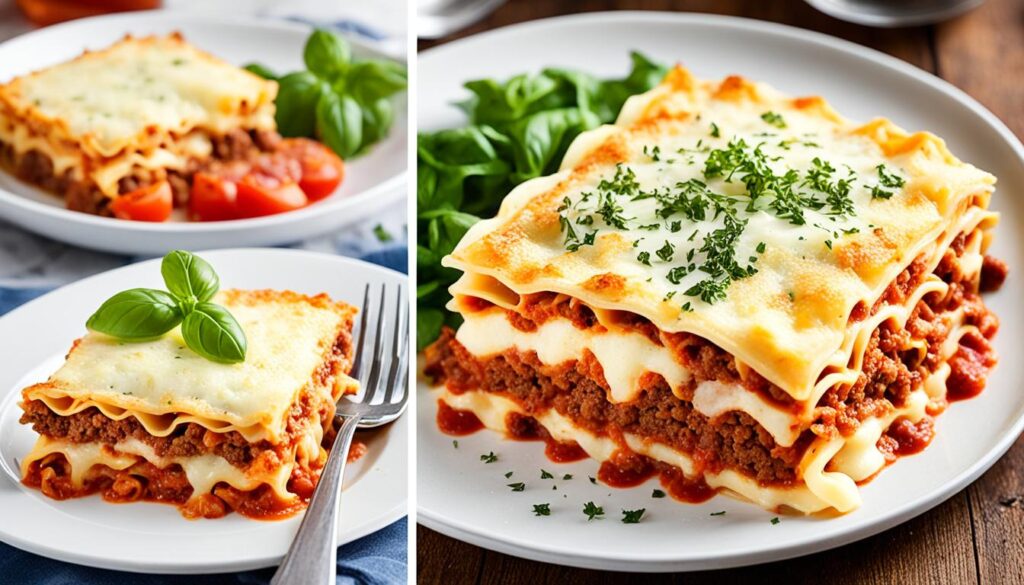
| Pastitsio | Lasagna |
|---|---|
| Layered with macaroni pasta | Layered with flat sheets of pasta |
| Uses a meat sauce | Can have a variety of fillings including meat, vegetables, or cheese |
| Topped with a creamy béchamel sauce | Topped with cheese |
The mix of blended ingredients that make up pastitsio give it a distinct taste and feel. It stands apart from lasagna, because its béchamel sauce is rich and creamy while the pasta provides a hearty base for the rest of the dish.
Having already learned what sets pastistio apart from lasagna, it’ll be easier to understand why this Greek recipe has remained so special over time. Its distinct blend of flavors are unique to Greek cuisine and cherished by many food enthusiasts..
Selecting the Perfect Ingredients for Your Pastitsio Recipe
Every ingredient in this dish plays a vital role in making it taste authentic. From beef to spices, you’re going to need the best stuff if you want your pastitsio to turn out right.
When looking at pasta selection, choose one that will hold shape under high heat and pressure. Misko no. 2 noodles are traditionally used, but feel free to use any other pasta type that will work with your other ingredients.
Lean ground beef is your best option when choosing meat for sauce. Although beef goes well alone, some people like mixing theirs with pork for extra flavor.
Spices play an important part in giving pastitsio its distinct Mediterranean taste. Ensure you have cinnamon, nutmeg and cloves on hand as they’re necessary seasonings for the meat sauce. You’ll also want freshly ground black pepper and salt as well.
Lastly, the cheese you select can drastically change how much flavor comes through in your final result. Kefalotyri or pecorino romano cheese both add a salty tang while Parmesan’s nutty flavor does well too. Choose one that melts easily and adds richness to your sauce.
By following these guidelines properly you can expect nothing short of delicious results from your own homemade pastitsio recipe! Next we’ll move onto our final section where we’ll dive into pasta types fit specifically fit for pastitsio.
.
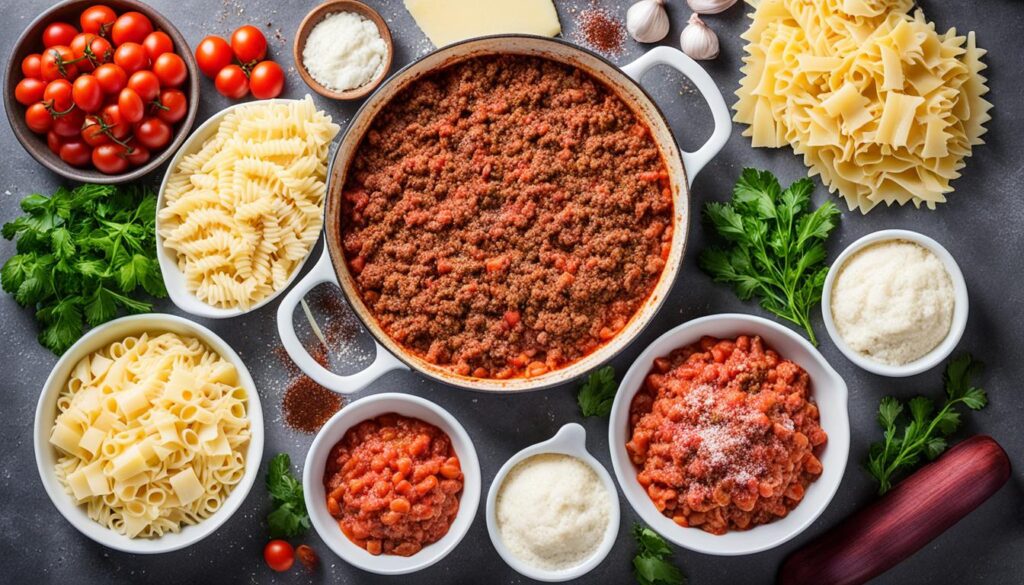
Choosing the Best Pasta for Authentic Pastitsio
When it comes to building authentic pastitsio, the pasta you use is monumentally important. To ensure that your dish has a perfect texture and flavor, you have to be mindful when selecting your pasta variety. The no. 2 Misko noodles are traditional and make food taste great on their own, but there’s still hope if you can’t find any..
Pasta Types Suited for Pastitsio
If you can’t find no. 2 Misko noodles, there are other pasta types that work just as well in pastitsio. Rigatoni, penne, ziti, or macaroni could all do the trick as well. These kinds of pasta have similar shapes and sizes which will still allow you to easily layer your dish while capturing the flavors in both sauces..
Preparing Pasta for Layering
Before you get into layering your ingredients in the pastitsio pan, make sure you cook your pasta right first. Boil it according to package directions, but keep an eye out for al dente cooking times. You want those pastas to be firm so they don’t overcook during baking and lose their shape — nobody likes mushy pasta.
Once cooked properly, drain them thoroughly before running cold water over them to stop the cooking process completely. This way your pasta won’t become too soft after everything’s done baking. Drizzle some olive oil onto them next and give them a good toss so they don’t stick together either.
Now that your pasta is prepared well enough for layers along with meat sauce and béchamel sauce, follow the instructions closely to create a delectable pastitsio every time!.
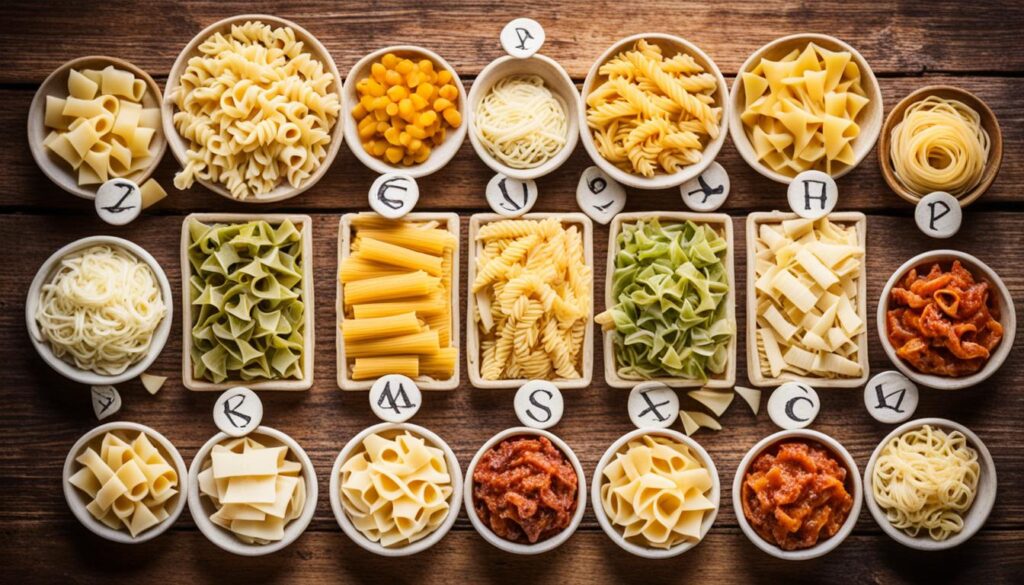
Creating a Flavorful Meat Sauce with Mediterranean Spices
The meat sauce is core to Pastitsio. A beautiful sauce gives it depth and a rich flavor. By using Mediterrean spices and ingredients, you can help improve the taste and smell of the sauce.
To create this sauce I recommend using both ground beef and ground lamb. Once cooked till browned, make sure to drain off any excess fat, lamb can be particularily fatty.
Then add spice such as oregano, cinnamon, and nutmeg. This will give your sauce that warm aroma. These will work wonders in complimenting the other layers in the dish.
To make this even creamier incorporate tomato paste and beef broth to amp up that richness. This will also give your sauce a thick consistency.
After all these ingredients have been mixed together let the mixture simmer for 30 minutes or more. The longer it simmers, the more flavorful it will become.
Once you’ve completed this step come back here for further instructions on layering your pastitsio! With a savory meat sauce each bite of your pasta will be unbelievably tasty.
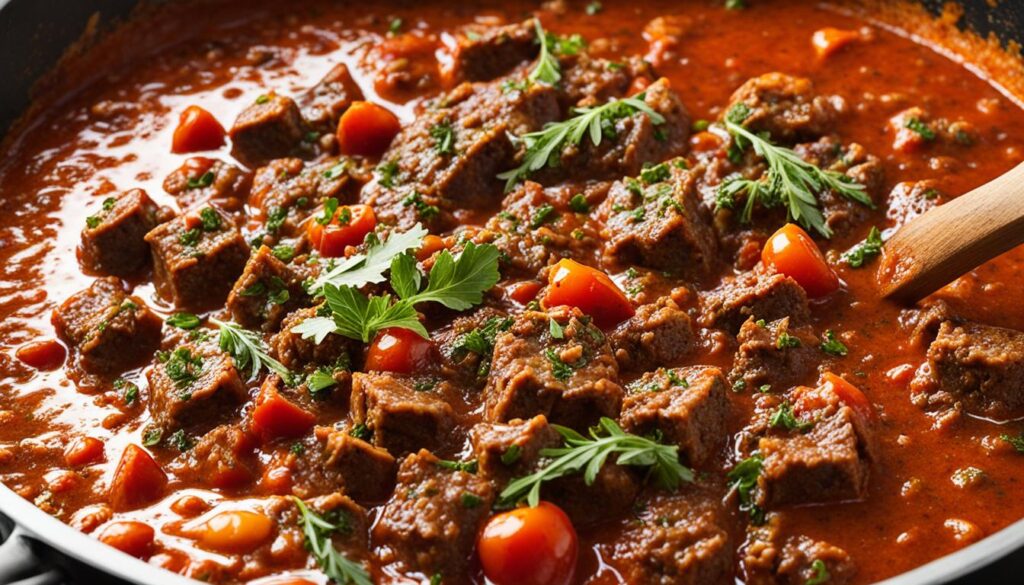
How to Make Creamy, Rich Béchamel for Pastitsio
The rich béchamel sauce is what sets pastitsio apart from the rest. It gives it that velvety texture and flavor you just can’t find anywhere else. In this section, I’m going to share all of the secrets to making a deliciously smooth and creamy béchamel sauce for your pastitsio. Let’s get started!
Secrets to Smooth Béchamel Sauce
There are a few key secrets to getting that perfect smooth consistency in your béchamel sauce.
- Whisk continuously: While you’re preparing the sauce, whisk it continuously so that lumps don’t form. This will give it that creamy texture we’re looking for.
- Cook over low heat: You want to make sure you cook this sauce on low heat so that the flavors develop gradually, and so that it doesn’t burn or become grainy.
- Add liquid gradually: When you add the milk or cream to the sauce, do so slowly while whisking. This will help keep everything evenly incorporated without any clumps forming.
- Simmer until thickened: Let the sauce simmer gently until it reaches your desired thickness, this will give it that rich and velvety consistency.
Incorporating Cheese into Béchamel
If you want to take your béchamel to another level, adding cheese is always a good idea! It adds a little extra creaminess and flavor to your pastitsio. Here’s how:
- Choose a flavorful cheese: Go with a cheese that melts well like parmesan, gruyere or any combination of those two cheeses. They’ll give your dish a nice depth of flavor..
- Grate the cheese finely: Make sure you grate your cheese finely so there aren’t any large clumps in the final product.
- Add cheese gradually: Add your grated cheese slowly into the sauce while whisking constantly. This will ensure an even cheese flavor throughout.
Layering Techniques for the Perfect Pastitsio Structure
The layering process is crucial in achieving the perfect structure and texture in pastitsio. To create a visually appealing and delicious dish, it’s important to follow the correct order of layers and ensure an even distribution. Let’s explore the layering techniques that will make your pastitsio a hit!
Order of Layers for Optimal Baking
When layering your pastitsio, it’s important to maintain a proper order to ensure even cooking and optimal flavor infusion. Here’s the recommended layering order:
- Start with a layer of cooked pasta at the bottom of your baking dish.
- Add a generous layer of meat sauce, evenly spreading it over the pasta.
- Next, spread a layer of creamy béchamel sauce on top of the meat sauce.
- Repeat the pasta, meat sauce, and béchamel layers until the dish is almost full.
- Finish with a final layer of béchamel sauce on top.
This layering technique ensures that each component of the pastitsio is evenly distributed and adds to the overall flavor and texture of the dish.
Tips for Even Layer Distribution
To achieve even layer distribution in your pastitsio, here are some helpful tips:
- Use a spoon or spatula to evenly spread each layer, making sure not to leave any gaps or uneven patches.
- Gently press down on each layer to compact it slightly, ensuring a solid structure.
- Distribute the ingredients evenly across the baking dish, paying attention to the corners and edges.
- Avoid overstuffing the dish, as it may result in uneven cooking and a messy presentation.
By following these tips, you’ll create a beautifully layered pastitsio that is visually appealing and provides a delightful balance of flavors in every bite.
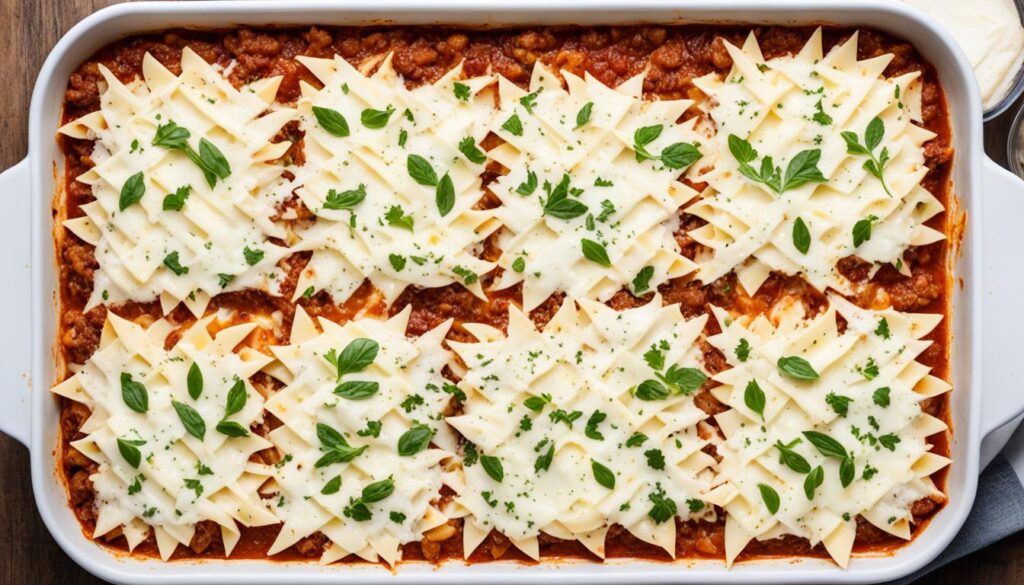
Cooking Tips: Achieving the Golden-Brown Deliciousness
To make an irresistible pastitsio, you’ve got to nail the golden-brown crust. Here are some tips for achieving just that.
First, preheat your oven to 375°F (190°C). This will make sure your dish gets cooked evenly and has a little extra crisp on top.
Once it’s up to temperature, bake your pastitsio for about 45-50 minutes. You’ll know it’s done when the top layer is a beautiful golden brown. But keep in mind that every oven is different, so don’t be afraid to check on it early.
For bonus color and crunch points, try broiling your dish near the end of cook time. All you need to do is switch the oven setting and pop it back inside for a few more minutes. Just keep an eye out so it doesn’t burn!
Following these tips will guarantee that crispy edge we all love in a casserole dish. Now let’s move on to uncovering our tantalizing pastitsio recipe.
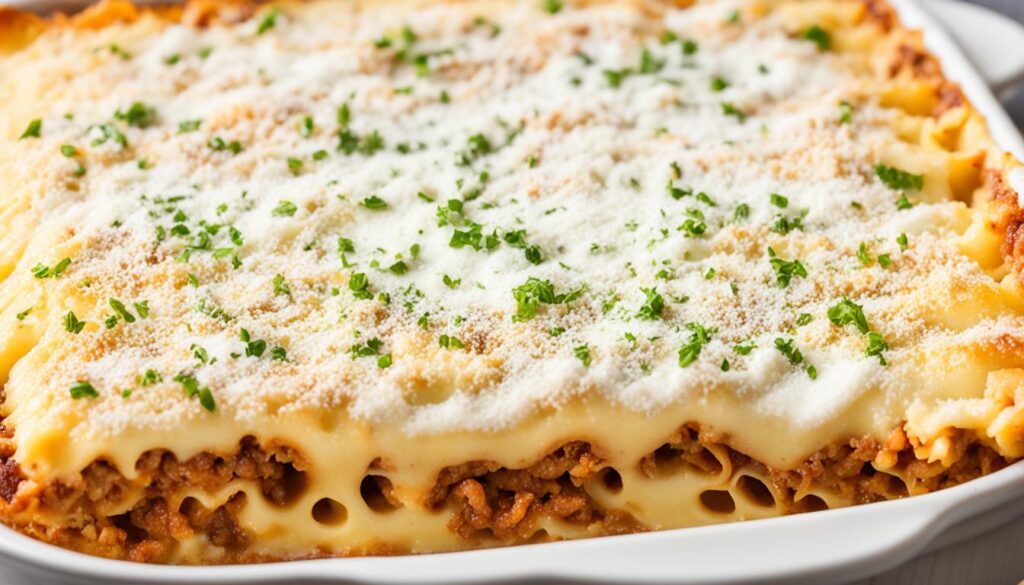
Pastitsio Recipe
Pastitsio Ingredients (serving size 4-5 people)
For the meat sauce:
- 1 pound ground beef/ lamb (your choice)
- 1 large onion, finely chopped
- 2 cloves garlic, minced
- 1 can (14 ounces) diced tomatoes
- 1 tablespoon tomato paste
- 1 teaspoon dried oregano
- 1/2 teaspoon ground cinnamon
- Salt and pepper to taste
- 1/2 cup red wine
- 250 ml beef stock
For the béchamel sauce:
- 4 tablespoons unsalted butter
- 1/4 cup all-purpose flour
- 2 cups whole milk
- 1/2 cup grated Parmesan cheese
- 2 large egg yolks
- Salt and pepper to taste
For the pasta:
- 10 ounces Misko no. 2 macaroni
- Water
- Salt
Pastitsio Instructions (Step by Step Guide)
- In a large skillet, cook the ground meat over medium heat until browned. Add the onion and garlic and cook until softened. Add wine and simmer for 2-3 minutes.
- Add the diced tomatoes, tomato paste, dried oregano, ground cinnamon, salt, and pepper, beef stock to the skillet. Simmer for 10-15 minutes until the flavors are well combined.
- Meanwhile, cook the macaroni according to package instructions in a large pot of salted boiling water until al dente. Drain and set aside.
- In a separate saucepan, melt the butter over medium heat. Whisk in the flour until smooth and cook for 1-2 minutes.
- Gradually whisk in the milk, ensuring there are no lumps. Cook, stirring constantly, until the sauce thickens.
- Remove the saucepan from heat and whisk in the Parmesan cheese until melted. Whisk in the egg yolks. Season with salt and pepper to taste.
- Preheat the oven to 350°F (175°C). Grease a 9×13-inch baking dish.
- Spread half of the cooked macaroni evenly on the bottom of the baking dish. Top with the meat sauce, spreading it in an even layer.
- Cover the meat sauce with the remaining macaroni, pressing down gently. Pour the béchamel sauce over the top, spreading it evenly to cover the pasta.
- Bake in the preheated oven for 40-45 minutes until golden brown and bubbling.
- Remove from the oven and let it cool for a few minutes before serving. Enjoy!

What to Serve Alongside Pastitsio for a Complete Meal
Complementary Side Dishes
Pastitsio is a one-man show, but it can become the headliner of a full meal when shared side by side with other dishes. Here are some suggestions that go well with pastitsio::
- Greek Salad: A salad so fresh, it’s nickname should be Freshy McFresh Salad. Cucumbers, tomatoes, red onions, olives and feta cheese make up this tangy treat.
- Tzatziki Sauce: This sauce cuts through the richness of the pastitsio like butter (except there’s no butter in this yogurt-based sauce).
- Roasted Vegetables: Zucchinis, eggplants and bell peppers join forces to add texture and flavor to any meal.
- Spanakopita: Greek spinach and feta cheese pastries are always a reliable appetizer or side dish.
- Marinated Olives: These olives are great at parties because they get along with everyone. Their Mediterranean flavor balances nicely with that of pastitsio.
These sides were made for the sole purpose of providing variety to your plate while balancing out pastitsio’s rich flavors. You can mix and match as you please depending on your taste buds!
Pairing the Right Wines with Pastitsio
Pastitsio is versatile when it comes to wine pairing. It works well with red and white. Here are some wine suggestions for your dish:
- Red Wine: A medium-bodied red wine like a Greek Agiorgitiko or Italian Chianti pairs well with the flavors of the meat sauce in pastitsio. These reds bring out both earthy and fruity flavors that can make for a delicious bite alongside your pasta.
- White Wine: If you prefer white wine, try serving up some crisp and refreshing Greek Assyrtiko or Italian Pinot Grigio instead. These options will provide a tangy contrast to your rich pasta sauce that’ll have you coming back for more.
Ultimately, the choice of wine depends on your personal taste preferences. Feel free to experiment and try different wine pairings to find the combination that you enjoy the most.
By serving complementary side dishes and carefully selecting the right wines, you can create a complete and memorable dining experience with your homemade pastitsio.
Preserving the Delight: Storing and Reheating Your Pastitsio
Pastitsio is the kind of dish that leaves you with extras to enjoy later. A blessing for people on-the-go needing a quick bite, because it’s still as delicious as ever when reheated. But be sure to follow proper storing and reheating techniques or else the flavors and textures aren’t guaranteed to hold up. In this section, I will provide you with valuable tips for storing your leftover pastitsio in the refrigerator and reheating it to retain its delightful taste..
Refrigeration Tips for Leftover Pastitsio
When it comes to storing leftover pastitsio, following proper refrigeration practices is crucial. Here’s what you need to do:
- Allow the pastitsio to cool completely before storing it in the refrigerator.
- Cut the pastitsio into individual portions, if possible, for easier storage and reheating.
- Place the individual portions of pastitsio in airtight containers or cover them tightly with aluminum foil.
- Label the containers with the date to keep track of the freshness.
- Store the pastitsio in the refrigerator for up to 3-4 days.
By following these refrigeration tips, you can preserve the flavors and quality of your leftover pastitsio.
Best Practices for Reheating to Retain Flavor
When it’s time to enjoy your leftover pastitsio, reheating it properly will help retain its delicious taste. Here are some best practices for reheating:
- Preheat your oven to 350°F (175°C).
- Remove the pastitsio from the refrigerator and let it sit at room temperature for about 15-20 minutes.
- Place the pastitsio in an oven-safe dish, if it’s not already in one.
- Cover the dish with aluminum foil to prevent the top from burning.
- Reheat the pastitsio in the oven for 15-20 minutes or until it’s heated through.
- For a crispy top, remove the foil during the last few minutes of reheating.
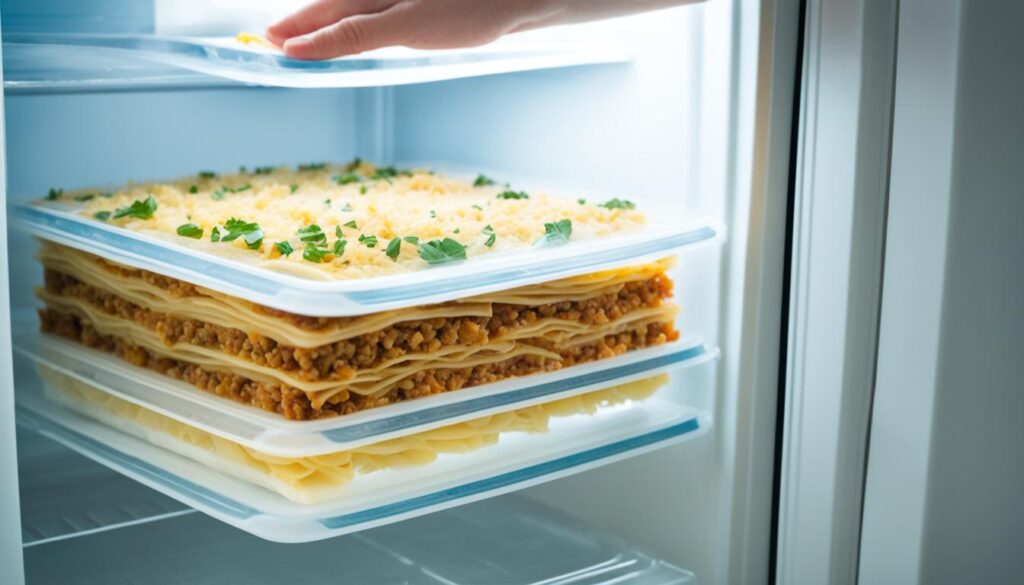
Adapting the Pastitsio Recipe for Special Diets
Special dietary needs should never stop you from enjoying the delightful flavors of pastitsio. The recipe can be adapted to suit various dietary restrictions, whether you follow a vegetarian, gluten-free, or dairy-free diet.
Vegetarians can simply eliminate meat and replace it with vegetables like mushrooms, eggplant or zucchini in the sauce. These veggies bring both a tempting texture and flavor that is comparable to the original meat-filled version. Tofu scrambled with your choice of seasonings or textured vegetable protein (TVP) are great sources of vegetarian protein that can be added to fill in for the missing meat.
If you are on a gluten-free diet, don’t worry about having to give up pastitsio! Replace regular wheat noodles with rice, corn or quinoa pasta options. Most grocery stores carry an assortment of gluten-free pasta so that no one has to miss out on this Greek classic. Follow cooking instructions on the package to make sure they’re perfectly al dente.
And lastly for those who don’t consume dairy, you’ll still be able to achieve the creamy béchamel sauce by using almond milk, coconut milk or oat milk as substitutes for regular milk used in recipes. Vegan butter or margarine can also substitute regular butter and there’s also many different dairy-free cheese options available on shelves now. These alternatives provide all the richness and flavor that make pastitsio such a comforting favorite dish..

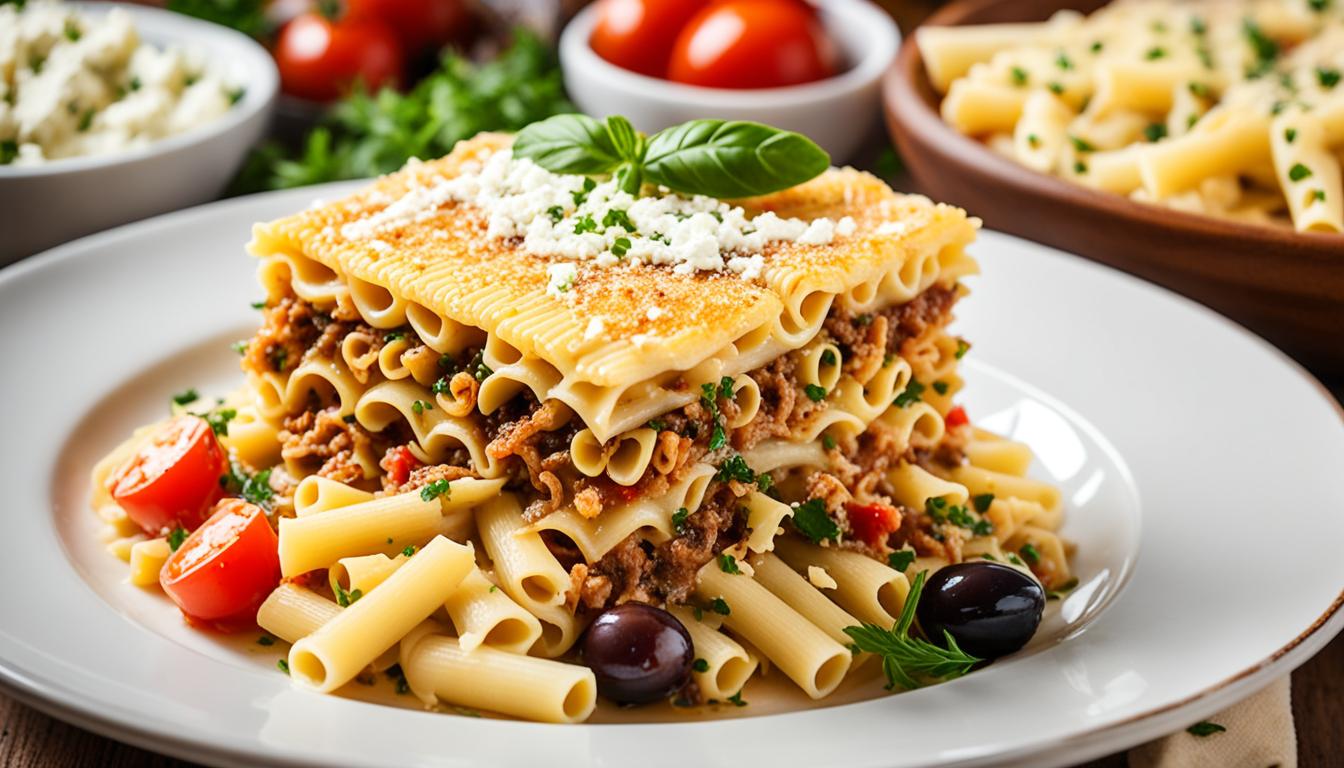
AI trash